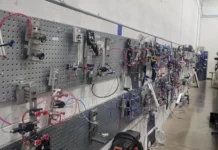by Donald C. Paulson, founder and owner
Paulson Training Programs
Scientific molding often is used to describe the ideal injection molding process, but what exactly does the term mean? Scientific injection molding (SIM) is the practical application of the laws of physics as they apply to molded parts properties. To understand molding as a science, you first must discard the idea that the machine control settings determine plastic part properties. Part properties, whether good parts or rejects, are determined by just four conditions:
- melt temperature
- plastic flow rate in the mold
- pressure of the plastic in the mold
- cooling rate in the mold
The key to understanding plastic processing is to understand how each of these four basic variables affects the plastic and how changes in plastic behavior affect molded parts. Listen to the molecules. When you have part problems, are you putting them at the wrong temperature, the wrong pressure, the wrong flow rate or the wrong cooling rate?
How do we understand molding as a science?
First, the initial requirement is that our molding machines, molds and any auxiliary equipment be capable and consistent in their operation. SIM specifies several machine/mold tests to accurately gauge the capability of the equipment. Examples include the machine’s ability to maintain consistent injection pressures independent of load; gate seal studies on the part(s); and checking for check-valve leakage, clamp force consistency and more. Procedures for these tests are widely available. The term “scientific injection molding” often is used for these tests, but the tests are just one component and the beginning of a truly scientific process. If injection molding is to get the benefit of actual science, there must be more to it than just machine/mold tests.
Second, a scientific injection molder must understand “molding from the plastics point of view.” Each of the 30-plus machine controls has an effect on one or more the four plastic variables. Today’s machines have the capability to control all of the plastic variables, but not directly. For example, there is no single control adjustment for melt temperature. Actual melt temperature (not barrel temperatures) is the result of many factors, including screw rpm, back pressure and heater settings. The value of understanding molding from the plastics point of view is that the knowledge tells you what set of machine controls to adjust and which ones to ignore.
The proof that plastic flow rate in the mold affects directional shrinkage, warp and part cracking was one of the reasons machine builders added fill-rate control. The development of velocity to pressure transfer setpoint (VPT) also was a direct result of research. Cavity pressure is much more consistent if a VPT setting near 95 percent of fill is set. Then, pack/hold pressure is used to adjust part dimensions. Step back and ask, “What is the goal of a scientific understanding in the injection molding process?” The answer is that the goal is the same as any innovation – to increase productivity and reduce problems.
The term I coined decades ago is “molding from the plastics point of view.” What does it take to become a scientific molder? An understanding of plastic behavior.
The four plastic processing variables
These four plastic variables determine final part properties, good or bad. As previously mentioned, no single machine control affects each of these variables independently of the other.
- Melt temperature. Plastic melt temperature affects the distance between the molecules. When melt temperature changes the molecules, distance apart changes. This creates a pressure loss during flow because the molecules moved closer together. Typically, flow viscosity decreases as melt temperature increases. For some materials, this effect is dramatic.
- Plastic flow rate. Flow speed differences across the flow path force the plastic molecules to line up (orient) in the flow direction. Oriented molecules have different properties in the flow direction versus the non-flow direction. This affects strength properties and differences in shrinkage and pressure loss during flow.
- Pressure. Plastic pressure in the mold determines part dimensions, shrinkage and stress.
- Plastic cooling rate. Faster cooling will freeze in molecular orientation; slower cooling reduces stress in the part. With crystalline materials, cooling rate directly affects crystal size and formation.
In summary, all of the properties of molded plastic parts are determined by one or more of these four processing variables. To the uninitiated, this sounds heretical. After all, there are at least 30 machine controls that seem to have the ability to affect part properties. It’s true – they do. But, from the plastics point of view, each machine control adjustment affects one or more of the four basic variables. Our goal then is to develop a multi-tiered production team, all with a scientific understanding of the molding process applicable to their jobs.
Donald C. Paulson, plastics engineer and longtime educator, is founder and owner of Paulson Training Programs and holder of nine US and European patents. For more information, call 860.526.3099 or visit PaulsonTraining.com.




